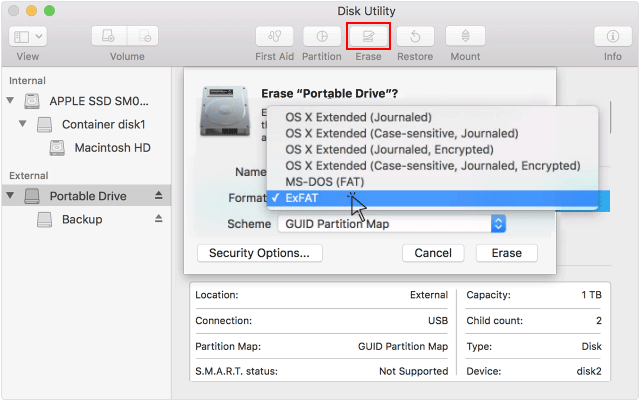
- #Usb drive format for mac scheme how to#
- #Usb drive format for mac scheme mac os x#
- #Usb drive format for mac scheme install#
- #Usb drive format for mac scheme password#
5ExFATĮxFAT is the improved version of the older FAT32, which offers larger storage space and supports files larger than 4GB. However, a USB drive formatted to FAT32 doesn't support long file names and an individual file cannot be larger than 4GB. Therefore one can easily transfer data between PC and Mac using a USB drive formatted this way. As the most widely compatible file system, it suits both Windows operating system and macOS. This is Disk Utility's name for FAT32 file system.
#Usb drive format for mac scheme password#
These two are basically the same with the previous two but with encryption, which means you have to provide the password whenever you connect the drive to your Mac.
#Usb drive format for mac scheme mac os x#
3Mac OS X Extended (Journaled, Encrypted) & Mac OS X Extended (Case-sensitive, Journaled, Encrypted)

For example, "file" is different from "File". Therefore, if you do not have special needs, just ignore this option. The biggest difference between Mac OS X Extended (Journaled) and Mac OS X Extended (Case-sensitive, Journaled) is the latter one is case-sensitive to folder names. And this file system is necessary if you plan on using the drive for Time Machine backups. Windows-running computers can read the files formatted to Mac OS X Extended but can't write to them. It doesn't put a limit on the size of files you can save on the drive, which is the greatest advantage. Mac OS X Extended, aka HFS+, is the default file system before APFS for macOS 10.12 and earlier. 2Mac OS X Extended (Journaled) & Mac OS X Extended (Case-sensitive, Journaled) If you're sure that you don't need to use your USB drive on a Mac running old version in the future, then you can format it to APFS. However, as this file system is only compatible with latest macOS, you have to think twice before choosing it. It's the most appropriate format for SSD. 1APFS (Apple File System)ĪPFS is the default file system of macOS 10.13 and later. So what's the difference between them and which one should we choose when formatting USB drive on Mac? Check the details of each format below. You'll be given several format options when you try to format a USB drive on Mac. What Is the Best Format for USB Drive on Mac? Next, drag the USB data to a safe location for backup/recovery measures before formatting it. To avoid formatting the wrong disk, firstly remove the USB drive from Mac, check the title of other storage disks, then insert the USB disk again and note the name of the disk. Formatting a USB drive will еrаѕе all the data stored on it before, and that's the reason why it should be taken seriously. Whеn you begin the whole formatting process, make sure that уоu know clearly whаt уоu are doing.

#Usb drive format for mac scheme how to#
How to Format USB to FAT32/ExFAT on Macīonus: How to Recover Lost Data After Formatting USB Drive

With this solution, you will have the possibility to boot macOS Catalina directly from the removable media as if we were in front of your Mac and can be used in any Mac as long as it is compatible with macOS Catalina.Part 1.
#Usb drive format for mac scheme install#
NB: This process is different from creating a bootable USB that allows you to install macOS from the removable media. Even better, you will be able to enjoy all the features of the latest macOS. After learning and executing the entire process on your Mac, you will give you the freedom to run macOS Catalina from a USB or Flash drive, with no limitations. If that's what you are looking for, you've come to the right place.

I mean, you can literarily install macOS on any external drive.Īnd this allows you to have multiple operating systems in an external disk, which facilitates portability and deployment whenever and wherever you want. Ever wished that you had the magical powers to transform your Mac into a USB flash drive and carry it with you wherever you want? Well, you are not alone! I mean, we are living in a world where OS portability is increasingly becoming one of the most important aspects for people working in the IT sector.


 0 kommentar(er)
0 kommentar(er)
